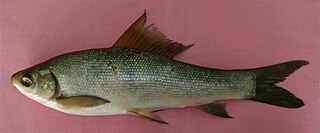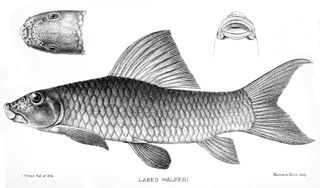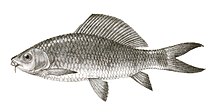
The rohu, rui, ruhi or roho labeo is a species of fish of the carp family, found in rivers in South Asia. It is a large omnivore and extensively used in aquaculture.

Catla, also known as the major South Asian carp, is an economically important South Asian freshwater fish in the carp family Cyprinidae. It is native to rivers and lakes in northern India, Bangladesh, Myanmar, Nepal, and Pakistan, but has also been introduced elsewhere in South Asia and is commonly farmed.

The Kuria labeo is a species of fish in the carp family, Cyprinidae. It is native to Pakistan, India, Bangladesh, and Burma, and it is known from Afghanistan and Nepal.

The orangefin labeo is a fish of the carp family Cyprinidae, found commonly in rivers and freshwater lakes in and around South Asia and South-East Asia. Native to Bangladesh and India.

Labeo angra is a species of fish in the family Cyprinidae, the carps and minnows. It is commonly known as the Angra labeo. It is native to Asia, where it is distributed in Bangladesh, Burma, Nepal, and Pakistan. It has also been reported from Afghanistan.

Labeo annectens is a species of fish in the family Cyprinidae, the carps and minnows. It is native to central Africa, where it occurs in several river basins, including the Congo River basin.

Gymnostomus ariza, the Reba or ariza labeo, is a cyprinid fish found in India, Nepal, Bangladesh, Afghanistan, and Pakistan.

Labeo bata is a fish in genus Labeo. It is commonly known as bata, and is a native fish to India and Bangladesh.

Labeo boga is fish in genus Labeo. It is in the family Cyprinidae and the Actinopterygii class which is widespread in India, Nepal, Bangladesh, Pakistan and Myanmar.

The fringed-lipped peninsula carp is a cyprinid fish in genus Labeo from Pakistan, India, Nepal, Bangladesh and Myanmar. It is listed as Least Concern in the global IUCN Red List of threatened species.
Labeo forskalii is fish in genus Labeo from Northeast and East Africa. The maximum total length of the species is 36 cm (14 in). It is under heavy fishing pressure in Uganda.
Gregori's labeo is fish in genus Labeo. It is found in the Tana and Galana Rivers in Kenya and Tanzania. IUCN reports it also from Juba, Somalia, and does not include Tanzania in the distribution area.

The Nile carp is a fish species in the genus Labeo. It feeds primarily on plankton, and is distributed along the entire Nile valley. It is generally believed to be the fish that swallowed the phallus of the Egyptian god Osiris in the myth regarding his death at the hands of his brother Seth.

Labeo pangusia is a species of fish in the genus Labeo. It occurs in mountain streams, lakes, river and ponds in northern India, Bangladesh, Pakistan, Bhutan and Nepal. Its populations are declining, the main cause seems to be the damming of the waters it lives in so that explosives can be set to catch other fish. This species is of minor importance for human consumption.

Labeo parvus is a species of fish in the genus Labeo from west and central Africa.
Labeo senegalensis is a species of freshwater ray-finned fish in the genus Labeo from West Africa.

Boggut labeo or the minor carp is an Asian freshwater fish of the family Cyprinidae. It is known from Pakistan, India and Bangladesh.

The mrigal carp, also known as the white carp, is a species of ray-finned fish in the carp family. Native to streams and rivers in India, the only surviving wild population is in the Cauvery River, leading to its IUCN rating as vulnerable. It is widely aquafarmed, and introduced populations exist outside its native range. It reaches a maximum length of 1 m (3.3 ft). This species and Cirrhinus mrigala are considered distinct.

The kalabans is a species of cyprinid fish found in streams in the Himalayan foothills in India, Nepal, and China. It is also found in Bangladesh.
















